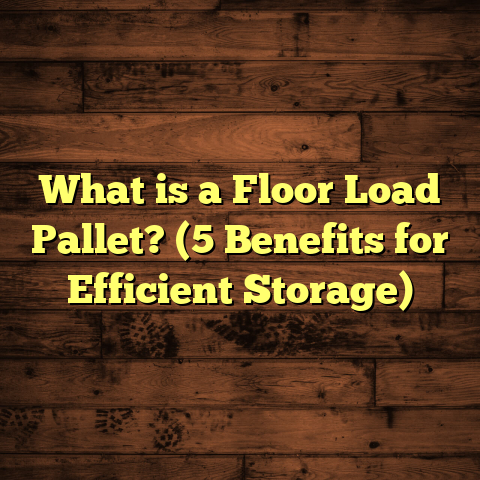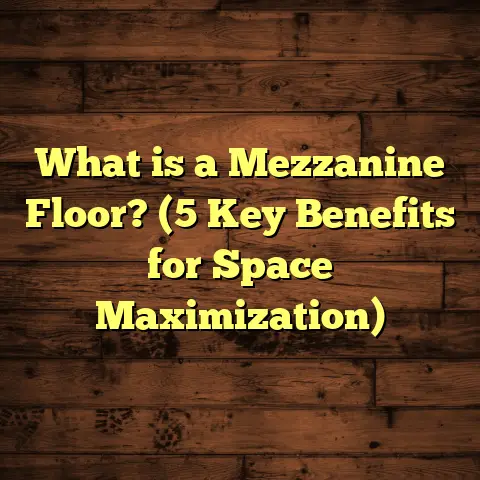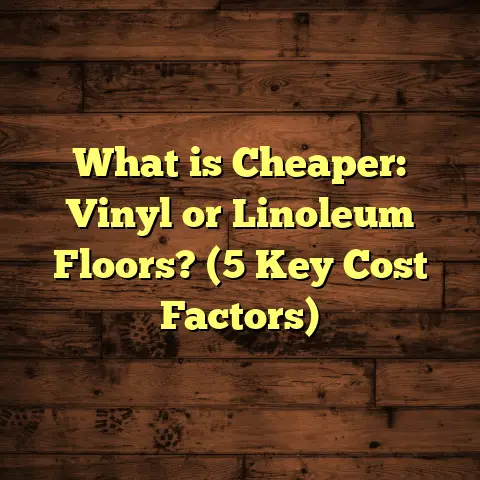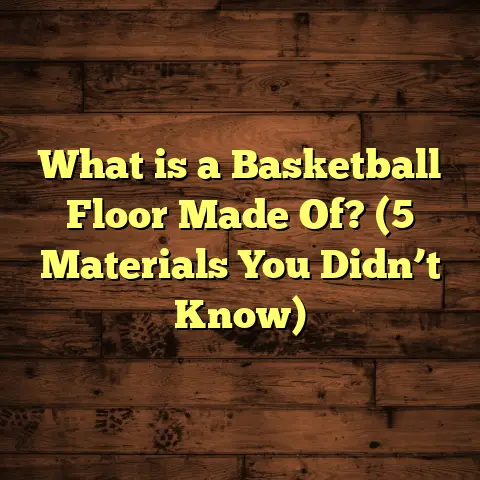What is Water Damage Through Flooring? (5 Key Signs to Watch)
What is Water Damage Through Flooring?
Have you ever stepped onto your floor and felt something just wasn’t right? Maybe a slight soft spot, or an odd smell lingering in the room? You might be wondering, “Could this be water damage?” I’ve encountered these questions many times from homeowners who thought a simple floor fix was all they needed—until water damage revealed itself in unexpected ways.
Water damage through flooring happens when moisture penetrates and settles beneath your floor’s surface. Whether it’s hardwood, laminate, vinyl, tile, or carpet, water can sneak underneath and cause serious problems over time. This hidden moisture can come from leaks, flooding, condensation, or even poor installation.
If left unchecked, water damage can lead to warped floors, mold growth, structural decay, and costly repairs. I’ve seen it happen in homes with all kinds of floors—each material reacts differently to water, but none like it.
The Many Faces of Water Damage in Flooring
You might ask: why does water under floors cause such trouble? Well, floors are designed to be stable and dry surfaces. When water enters, it disrupts this balance. Here’s a quick breakdown:
- Wood floors absorb water and swell;
- Laminate floors delaminate or warp;
- Vinyl floors peel or bubble;
- Carpets trap moisture leading to mold;
- Tiles can loosen as grout erodes.
In every case, moisture leads to physical damage and health risks.
Why Is Water Damage Under Floors So Sneaky?
One thing I’ve learned working as a flooring contractor is that water damage isn’t always obvious. Unlike a burst pipe spraying water everywhere, leaks beneath floors are quiet and invisible until serious damage has already started.
Sometimes it’s a slow drip from plumbing hidden under the floor or behind walls. Other times it’s condensation building up due to poor ventilation. Flooding can soak into subfloor materials without anyone realizing until smells or warping appear weeks later.
This invisibility is why knowing the early signs of water damage matters so much. Catching it early means you can fix the issue before the damage spreads.
5 Key Signs of Water Damage Through Flooring to Watch For
Now let me break down the five key signs I look for on every job. These are clues you can keep an eye on at home to spot trouble early.
1. Warping and Buckling: Floors That Don’t Lie Flat
When your hardwood or laminate flooring starts lifting or bubbling up, it’s a red flag. Wood naturally expands when it absorbs moisture, but because it’s nailed or glued down, this expansion causes warping or buckling.
I remember working on a renovation where the client complained about uneven surfaces in their dining room. Pulling up the boards revealed weeks of hidden leaks from a dishwasher hose that had slowly burst. The wood planks were swollen and unusable.
Warping also creates safety hazards—imagine tripping over raised flooring in your own home!
2. Discoloration and Stains: When Floors Show Their True Colors
Have you noticed dark spots or yellowing on your wood or carpet? Water changes how materials absorb light and color, often causing stains that won’t wash away.
According to research by the National Wood Flooring Association, nearly 40% of wood floors exposed to moisture develop visible discoloration within just two weeks. So if you see new stains suddenly popping up, don’t ignore them.
In a job I handled last year, the client had a beautiful oak floor suddenly showing blotchy dark patches near the bathroom door. The problem? A leaking toilet base that had soaked under the floorboards for months.
3. Musty or Moldy Odors: Smells That Say “Something’s Wrong”
Nothing signals moisture problems quite like a persistent musty smell. Mold and mildew thrive in damp conditions and release spores that cause that distinct odor.
One client’s carpet smelled fine when we started but after pulling it back, we found mold growing on the padding underneath from condensation seeping through concrete. It was a wake-up call for them.
The EPA reports that about 60% of indoor air quality problems link back to moisture issues like hidden leaks or wet flooring—making odors one of the first warning signs.
4. Soft or Spongy Areas: Floors That Give Way
Have you walked across your floor and felt a spot that sinks or squishes underfoot? That softness means wood or subfloor materials have absorbed water and lost strength.
On a bathroom remodel project, I noticed some tiles felt springy when stepped on. Removing them revealed plywood that was rotten from years of unnoticed shower leaks.
Soft spots are dangerous because they indicate weakened support structures—something no homeowner wants underfoot.
5. Peeling or Bubbling Flooring Materials: Surfaces That Refuse to Stay Put
Vinyl or laminate flooring often peels away or bubbles when exposed to water. This happens because water breaks down the adhesive bond holding these layers together.
A client once told me their kitchen vinyl started lifting around the sink area. We traced it back to a slow drip from a loose faucet seal.
Fixing the leak and replacing the damaged sections prevented further spreading damage—and saved them money down the road.
Why Water Damage Happens Beneath Your Floors
Leaks aren’t always obvious sources of trouble—sometimes it’s poor design or maintenance issues that allow moisture to settle where it shouldn’t.
Here are common causes I’ve seen:
- Plumbing leaks: Pipes running beneath floors often develop small cracks or loose fittings.
- Appliance failures: Dishwashers, washing machines, refrigerators with ice-makers can drip unnoticed.
- Flooding: Heavy rains or burst hoses cause water intrusion.
- Condensation: Poor ventilation traps moisture especially in basements or crawl spaces.
- Poor waterproofing: Floors not sealed properly allow seepage from outside or below ground.
Homes with basements or slab foundations are especially vulnerable because water collects near or under floors easily.
How Does Water Damage Affect Different Flooring Materials?
Not all floors react to water the same way. Here’s what I’ve learned about common types:
Hardwood Floors
Water causes hardwood to swell, warp, and cup (edges higher than center). Prolonged exposure leads to rot and mold inside joists below.
Laminate Floors
Laminate planks tend to delaminate—that is layers separate—and swell at edges causing unsightly gaps and buckling.
Vinyl Flooring
Water seeps under vinyl sheets or tiles causing bubbling and adhesive failure.
Carpet
Carpet traps moisture in fibers and padding promoting rapid mold growth and odors that linger even after drying.
Tile Floors
Water often damages grout lines causing tiles to loosen or crack over time.
Real Numbers: How Common Is Water Damage in Flooring?
I found some statistics that might surprise you:
- According to the Insurance Information Institute, around 30% of homeowner claims relate to water damage.
- The average cost of water damage repairs ranges from $2,500 to $7,000 depending on severity.
- Mold remediation alone can add $500 to $6,000 on top of flooring replacement costs.
- Nearly 40% of homeowners with hardwood flooring report some form of water damage during their ownership period.
Knowing these numbers helps me understand how important early detection is—not only for safety but also cost control.
How I Personally Diagnose Water Damage on My Jobs
When I get called out for suspected water damage, here’s my usual approach:
- Visual inspection: I look for warping, discoloration, stains, bubbling.
- Smell test: Any musty odors raise immediate suspicion.
- Touch test: Feeling for soft or spongy areas.
- Use moisture meters: These tools measure moisture content deep within floors accurately.
- Lift flooring if needed: Sometimes you have to remove carpet or tiles to see underneath.
- Inspect plumbing/appliances: Confirm if leaks are active before repairs start.
This thorough method helps me avoid missing hidden problems others might overlook.
Case Study: Basement Flood Turns Into Flooring Nightmare
Let me tell you about a project that really stuck with me. A family had frequent basement flooding after heavy rains but thought they just needed better sump pumps. When we removed old carpet and padding during their flooring overhaul, we discovered soaked plywood subfloor with mold growing underneath.
The repairs involved removing all damaged materials, treating mold professionally, upgrading drainage around the home, then installing waterproof vinyl planks designed for basements.
The family learned firsthand how ignoring small leaks caused bigger problems—and how choosing appropriate flooring materials matters in wet areas.
Can You Fix Water-Damaged Floors Without Replacing Them?
Sometimes minor water damage can be repaired without full replacement. Here are a few options I’ve tried successfully:
- Drying out with fans/dehumidifiers: For minor dampness caught early.
- Sanding and refinishing hardwood: Removes surface stains and warping if damage is minimal.
- Replacing damaged planks: Instead of full floor replacement.
- Using sealants: To prevent future moisture absorption.
But for extensive rot, mold, buckling—replacement is usually necessary to protect home safety long-term.
Preventing Water Damage Under Floors: Tips from Experience
Avoiding water damage is easier than fixing it later—I always advise these steps:
- Regularly inspect plumbing for leaks.
- Fix appliance issues promptly.
- Use waterproof mats near sinks/washing machines.
- Ensure proper ventilation in basements/crawl spaces.
- Seal floors with appropriate waterproof coatings.
- Use moisture barriers under flooring in high-risk areas.
I tell clients prevention saves thousands in repairs later—and keeps homes healthier too.
How Tools Like FloorTally Help Me Manage Water-Damage Risks in Flooring Projects
When estimating costs for projects where water damage might be involved, I rely on FloorTally. It lets me:
- Enter local labor/material costs for accurate budgeting.
- Add contingencies for potential water damage repairs.
- Calculate waste factors considering damaged material removal.
- Compare costs between different flooring types suitable for wet areas.
Using FloorTally saves hours of guesswork and helps me set realistic expectations with clients upfront—especially on tricky jobs involving water issues.
What About Mold? The Hidden Threat Below Your Floor
Mold loves damp environments and can colonize quickly under wet flooring. It releases spores causing allergic reactions or respiratory problems for anyone exposed long-term.
It’s not just carpet padding that molds—mold can grow on wooden joists, drywall near floors, even concrete slabs if moisture is present.
That’s why mold remediation often accompanies water damage repair projects—removal plus treatment prevents health hazards from returning later.
Does Flooring Type Influence Your Risk?
Absolutely! Not all floors handle moisture equally well:
- Tile and stone are naturally water-resistant but grout lines need sealing.
- Vinyl offers good resistance but adhesive failure can cause peeling.
- Engineered hardwood fares better than solid wood in moist environments.
- Laminate is highly vulnerable to swelling.
- Carpet fares worst due to absorption and mold risk.
Choosing the right flooring for your home’s environment reduces chances of water damage dramatically.
Signs You Should Call a Professional Right Away
If you notice any of these signs don’t wait:
- Persistent musty smells that don’t go away
- Large areas of warping or buckling
- Soft spots that feel unsafe underfoot
- Visible mold growth
- Standing water under floors or near appliances
Professional inspection can prevent serious structural damage and health risks down the line.
Final Thoughts from My Flooring Experience
Water damage through flooring is tricky because it hides below surfaces but causes visible problems fast once it spreads. Knowing what signs to watch for helped me save many homeowners thousands in repairs—or worse health issues due to mold.
If your floor feels off even slightly—warped boards, odd stains, soft spots—don’t ignore it. Investigate early with simple checks or call an expert who can use tools like moisture meters for proper diagnosis.
Remember: prevention beats repair every time. Regular maintenance combined with smart flooring choices protects your home from costly water damage headaches.
Have you ever had to deal with water damage in your flooring? Or maybe noticed subtle signs but weren’t sure if they meant trouble? Feel free to share—these stories help all of us stay ahead of problems!





